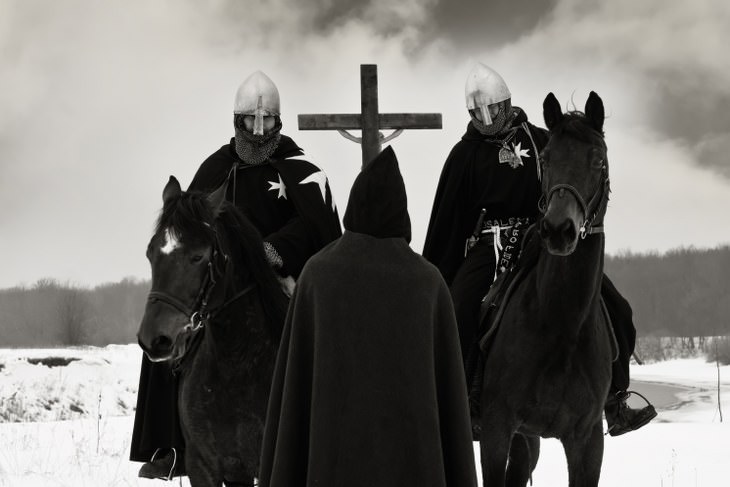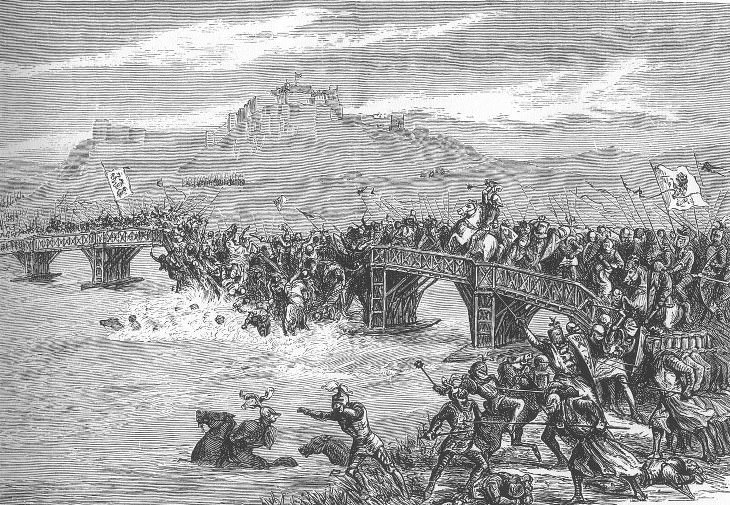

Napoleon's 1813 defeat by allied forces at Leipzig is historically important because it marked the first significant cooperation by European countries against a common enemy. In spite of his defeat in Russia, Napoleon was confident that he could resume his offensive since he believed that the other European countries were too distrustful of each other to consider joining forces, which is why he began his advance into Germany in early 1813.
Much to Napoleon's displeasure, Karl von Metternich, the foreign minister of Austria, started to assemble a coalition of European nations against him, including Russia, Prussia, Great Britain, Sweden, and a few other countries. This, however, did not deter Napoleon, and he still crossed into Germany, planning to defeat each opposing army before the 'allies' could catch up with him.
Napoleon was victorious at several of the first few battles and even defeated the Prussians at Lutzen on May 2. However, his new army was nowhere near as experienced as the one he had lost in Russia, and after a string of defeats and a refusal to accept a peace agreement, his army of 175,000 men ended up in Leipzig in September, surrounded by 350,000 European soldiers and 1,500 pieces of artillery.
After a couple of days of battle, it became clear that Napoleon's army had no chance of withstanding a war of attrition, especially not when it was surrounded by enemies. The odds of a victory for Napoleon were further reduced when a unit of Saxons deserted the French to join the other side, and the Swedish army showed up to support the Allies.
After Napoleon's attempt to set up a truce was refused by the Allies, the French army retreated westward by crossing the bridge over the Elster River, which was the only way across. Around 30,000 soldiers served as a rearguard during the crossing, most of whom became stranded when the bridge was destroyed. While a few of them managed to swim to safety, the majority of them were either captured or killed.
After yet another crushing defeat, the worst was still not over for Napoleon, since the Allies then decided to invade France in December 1813, before exiling Napoleon after defeating his army in Paris on March 30, 1814. Even that didn't convince him to give up though, which is why he would then go on to suffer his final defeat in the Battle of Waterloo on June 18, 1815.

Christopher Columbus was not the first invader that the Native Americans had ever encountered since Norse colonists had already been there around five centuries earlier, as has been proven by archeologists and Norse legends that talk of a place called "Vinland," which turned out to be Canada.
"Skraeling," meaning "weakling" was an insult used to describe the Native Americans by the Vikings. However, it soon turned out that the Native Americans were far from weak. While the Vikings and Native Americans initially lived in peace together, the vast cultural differences between them soon spiraled out of control into a full-blown skirmish.
This skirmish started out with four Native Americans and two Vikings being killed. After that, the Native Americans got really mad and deployed a weapon launched from poles, which had a large blue ball at the top that emitted a sound that the Vikings found unbearable. Shortly after this skirmish, the Vikings eventually decided to leave this strange land for good, since as documented in The Saga of Eric the Red, they soon "realized that even though this was good land, their lives here would always be dominated by battle and fear."

The early 13th century was a very trying time to be Russian, since so many nations kept on attacking them, one after another. After fending off attacks by both the Mongols and the Swedes, Russian troops were desperately depleted by 1242, which is exactly when the Christian Crusaders decided to show up at their doorstep.
The Crusaders claimed that the Russians' Eastern Orthodox Christianity was heretical, so they sent forth some of their strongest knights from the Livonian branch of the Teutonic Order, who were among the most elite and heavily-armored knights on the planet at the time.
The only opposition that the Crusaders found was the rabble of the Novgorod Republic, which was one of the last remaining Russian principalities that survived the previous invasions. The Russian army merely consisted of some poorly armed local militiamen, a couple of princes, and a handful of their guards.
The Battle of the Ice happened on April 5, 1242, on the frozen fields between the southern and northern parts of Lake Peipus. The ice there was not flat, but sharp and jagged instead. Upon seeing this, the Crusaders were not deterred and decided to charge across it anyway, in spite of their ridiculously heavy armor.
The Crusaders ended up engaged in hand-to-hand combat for hours on end while on this slippery surface against the local militiamen, who were standing safely on a beachhead until the invaders finally decided to turn tail. However, this wasn't the end of their woes, since during their retreat the ice supposedly collapsed underneath them, causing many of them to drown or freeze to death.

On Dec 11, 1878, the British Empire delivered an unjust ultimatum to Cetshwayo, the African Zulu king with the intention of using it to start a war. When the terrible offer was predictably refused by the African king, the British immediately mobilized an army of 8,000 men towards Africa.
The Battle of Isandlwana was the first major battle of the Anglo-Zulu War, taking place on Jan 22, 1879, in Isandlwana, South Africa. The British entered South Africa with the best of everything that any army had ever seen. Their opponents, on the other hand, fought with iron thrusting spears, clubs, throwing spears and shields made out of cowhide.
Apparently, the superior technology on the side of the British Empire made them extremely overconfident. In fact, they were totally unprepared to deal with the chaotic fighting style that the Zulus had adopted. This led to a huge and bloody siege, which ended with the single worst British defeat against a technologically inferior opponent.
As for the victors, the Zulus managed to capture close to 2,000 draft animals, two cannons, 130 wagons, 1,000 Martini-Henry rifles, 400,000 rounds of ammunition, tents, beer, biscuits, tinned food, tea and plenty of clothing.

The Battle of Stirling Bridge, fought on Sep 11, 1297, was meant to be a walk in the park for England, particularly because they outnumbered their Scottish rivals five to one. While the Scots merely had around 2,000 soldiers and 300 horses, the English army had between 8,000 and 10,000 soldiers and between 1,000 and 2,000 cavalry units.
What made the odds even worse for the Scottish was the fact that the English had possession of a large number of English longbows, which were the most feared weapons in the world at the time. Luckily, the Scots had the brilliant William Wallace on their side, who is described in the chronicle Scotichronicon as "a tall man with the body of a giant."
Wallace was painfully aware of the fact that this was no fair fight, and that a war of attrition would ruin them. That's why he came up with the cunning plan to stand in a square formation (to help avoid most of the arrows) and force the English army into a bottleneck - the narrow Stirling Bridge.
Since Stirling Bridge was only wide enough for a couple of mounted units to cross simultaneously, the Scots were able to line up at the other end and attack them one or two at a time. In this way, close to 50% of the English army was butchered. One of these was including the English treasurer to Scotland, Hugh de Cressingham, who was flayed and turned into underwear after his death as a sign of disrespect.
Sources: historyplace, cracked
Images: depositphotos, wikimedia